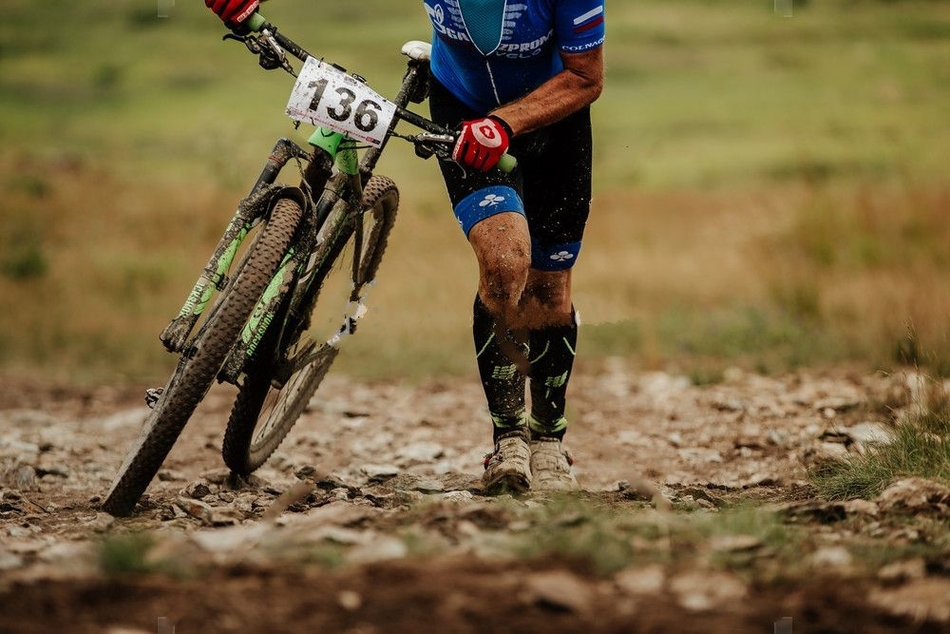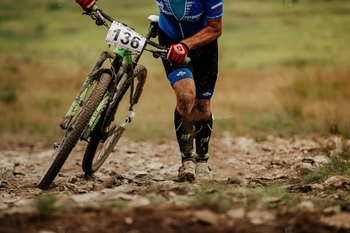
Socks specifically for mountain biking are becoming more popular, especially longer socks. I thought everyone just folds their socks down. So I researched to find the reasons for long socks.
Why do mountain bikers wear long socks? Mountain bikers wear long socks because they offer protection from ticks, poison ivy, low bushes and branches. They stop sand and pebbles from getting into socks, prevent sweat from getting into shoes. and protect against pedal strikes. Longer socks offer more space for fashion and design, they keep calves and feet warmer, and they are manly.
Let’s get into how mountain bikers actually use longer socks for their benefit.
What Are Long Mountain Bike Socks Good For
- A lot of mountain biking takes place in the forest and depending where you ride you have to be careful of ticks. If a tick bites you, you could get Lyme’s disease. Long socks are excellent protection from this danger.
- Along with ticks which are dangerous there is poison ivy. One brush up against poison ivy as you ride by and you could get its poison on your skin. If this happens a rash, blisters and plenty of itching are what is in store for you. And it does not go away so fast. Use long socks.
- Singletrack trails are narrow by design. In the forest low bushes and branches can hang over singletrack trails very easily. You can really scrape up and scratch up your skin as you pedal by. Longer socks offer a layer of protection from this.
- Riders who have worn short socks have switched over to long socks. They say that they kept getting sand and pebbles falling into their short socks. This caused them a lot of discomfort and scratched their skin up. After time they would need to empty out their short socks, so go with longer ones.
- Mountain biking can be a tiring and sweaty ride. Sweat can run down your legs and make your ankles and feet wet. Longer socks can trap that sweat and then wick it away. This will keep your feet dry and comfortable.
- Mountain bikers ride on rough terrain like roots and rocks. A rooted trail or a rock garden can be pretty bumpy. Your foot could slip from the pedal and scratch your ankle or shin. This can be painful and irritating. Long socks can save you from this pain and injury.
- Mountain biking has become a culture of its own making. Some riders like to brand themselves as a particular type of rider. Since longer socks can be easily seen on the trail they like to get longer socks which have some kind of design that matches their riding personality.
- During the winter it is cold and it gets even colder due to the wind chill factor when you are riding. Long socks will keep your calves and feet warmer than short socks will. This will improve your circulation and keep you comfortable longer.Plus they are waterproof which keeps you dry.
- Lastly mountain bikers especially guys, like to think or mountain biking as very manly. Which is cool, and it is. That is why many prefer to wear long socks. Some think short socks are girly and would not be caught dead wearing them on the trail. To each their own.
Long Mountain Bike Socks vs Long Socks
Many riders want to wear long socks which are specific for mountain biking and not just any kind of long sock. One reason is they do not want to dirty up their long white socks. Long white socks will get dirty very quickly on the trail.
Other types of long socks are not tight enough to handle the impact of mountain biking so they will fall down the leg are some time. You don’t want to have to keep pulling up your socks on the trails. This is distracting and could cause an accident if you have to stop often.
Long socks not made for riders are usually made from cotton. Wearing these socks all day will make your feet hot, sweaty, and smelly. Cotton does not wick away sweat or keep your feet cool and dry. If wet you could get athlete’s foot.
What Fabrics Are Long Mountain Bike Socks Made Of
- Merino wool is very good at wicking away sweat and evaporating moisture in order to keep your feet and longer leg dry. It is very soft, cushions your feet, does not itch and is a strong material. Merino does not shrink and it fights odors and bacteria.
- Many riders think that wool should only be worn during the winter time. But this type of wool is very breathable so you can wear it all year long. This saves you money, you don’t need to buy winter socks and summer socks.
- Acrylic will also save you money because you can wear it 12 months of the year. It is less expensive than Merino wool. It is comfortable which makes wearing your shoes more comfortable. It supports your feet with cushioning and acrylic dries quickly.
- Nylon dries fast and does not absorb a lot of water keeping your feet dry. It is soft, warm, and lightweight. Nylon is normally mixed in with other fabrics to increase the socks strength and resistance to tearing. It is a good idea to include Nylon in any sock you use.
- In order for long socks to fit more perfectly to the shape of your calve and foot Spandex, Lycra, and Elastane are added to the sock. These fabrics make the sock more elastic and flexible. These material only comprise 2% to 5% of the socks total material to enhance its fit on your foot.
How Thick or Lightweight Should Long Socks Be
If you are a cross country rider in summer you can go as thin and light as you can without injuring your feet. You still want to have some support to avoid causing any blisters or abrasions. You also want to make sure they are thick enough for your shoes. You don’t want your feet sliding around.
Downhill riders will want to have a thicker long sock. This will add more cushioning for your feet as you speed down the hill. The impact of your foot on the pedals needs to be supported, especially where the edges of the pedal make contact with your foot.
Winter mountain bikers definitely will benefit from thicker heavier socks. They will be warmer and keep the circulation going. Protection against frostbite if you are riding all day is of concern. Thicker long sock are useful as well for more of a snug fit if there is extra room in your shoes.
How Should Long Mountain Bike Socks Fit
- Long socks should fit snugly around your toes but not too tight. You should be able to curl your toes in and lift up your toes from the floor when your feet are flat. This is especially important when using clipless pedals. You don’t want your toes to feel trapped.
- The rest of your foot should feel snug in the socks. Your sock should not feel as though it has to stretch around your foot, that is too tight. On the other hand it should not be loose either. There should not be extra material in the heel area. The heel of the sock should be lined up with the heel of your foot.
- The long part of the sock should feel a little tight around your ankles and calves. It should be tight enough so it does not fall down your leg. But not too tight that it block circulation. If you pull on the part of the sock covering your calves the sock should moderately snap back in place.
- Lastly, your toes and heel are very important when it comes to comfort. Check where the seams are on the socks. You do not want to have seams at the tip of your toes, the seam is better on top. Plus you don’t want a seam under your heels. Proper seams should enhance the fit.

